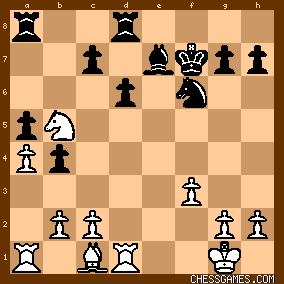KEG: Post II
Ragged play by both sides ensued after an even ending was reach with 13...Nxe4: 14. f3 Nf6
15. Nc3
15. Nd2 or 15. Be3 were better.
15... Be7
Starting here, Sterling repeatedly declines to play the freeing and equalizing d5 until move 36 (by which time it was a dreadful mistake). The text, though inferior to 15...d5, is not terrible in itself. It is, however, the beginning of a bad endgame plan by Sterling that soon lands him in trouble. 16. a4
This effort to neutralize Black's Queen-side pawn majority was a sensible plan by Didier. 16. Ne2 would also have been good. 16... b4
17. Ne2 a5
Once again, 17...d5 was better, as would have been 17...Rhe8. 18. Nd4!
Seemingly set on exploiting the White-square weaknesses on Black's Queen-side. 18... Ra8
19. Nb5 Rhd8
Still avoiding 19...d5, which even now would have given him a fully satisfactory game. The position was now:

click for larger view20. c4?
Throwing away his chances to try to capitalize on Sterling's weak play. Didier was nowhere near a win here, but his best prospects lay in the very move denounced as an error by Rosenthal in the Tournament Book. But after 20. Nxc7 Rac8 21. Nb5 Rxc2 Didier could have mustered some advantage with 22. Nd4. With the text, he gives Sterling a chance to turn the tables with 20...d5. 20... c5?
Sterling's allergy to playing d5 continues to ruin his chances. Sterling could have solved all his problems with 20...d5. With his actual moves, he creates new weak squares on his Queen-side, and a dangerous weak pawn on d6. 21. Bf4!
The best way to punish Sterling's strange lapses. 21... Ra6
22. g4
Having created targets on the Queen-side, Didier strangely shifts his attention elsewhere. 22. Rd3 or 22. b3 were better. 22... Rc6
23. h4 h6
24. b3
Having said "A" he should play "B" with 24. g5. The text should have allowed Sterling to equalize. 24... Ne8
Sterling is still unwilling to play d5. The text gives Didier a second chance to play g5, and this time he goes for it. 25. g5 hxg5
26. hxg5 g6
27. Ra2 Ng7
28. Rh2 Nh5
Only driving White's Bishop to a square with better prospects. Sterlin should here have played 28...Rcc8. 29. Bc1 Rd7
30. f4
The position was now:

click for larger viewDidier has the better chances here, but is nowhere near winning. With his next two moves, however, Sterling gives Didier what should have been a clear and easy win. 30... Ng3?
Pursuing a delusion. 30...Rc8 gave him good chances at survival. 31. Bb2
"Very well played. This move gives White the advantage." (Rosenthal in the Tournament Book). This is one of the few comments by Rosenthal with which I agree. 31... Ke6?
31...Nf5 or 31...Bf8 were his only real chances. With the text, Black marches his King into what should have been fatal trouble. The position after 31...Ke6? was:

click for larger viewDidier could and should have made short work of Sterling from this position. But as I will discuss in my next post on this game, Didier managed to ruin his winning chances and bring himself to the verge of defeat in just eight moves. | 




